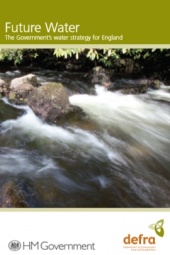Future Water, The Government’s water strategy for England
In 2008, the government published Future Water, The Government’s water strategy for England. The strategy was published as a response to the 2004-06 South East of England droughts and the floods of 2007. It set out the government’s vision for the water sector in 2030 and the measures proposed to help deliver that vision.
In the Foreword, the then Secretary of State for Environment, Food and Rural Affairs, Hilary Benn said:
“In England, the average person uses about 150 litres of water a day – that’s about a tonne a week!... The South East and East of England already face increasing demand on a finite water supply. The drought of 2004-06 was only managed through controls on what we could use water for. This was not a one-off; indeed droughts are likely to be more common. By 2080, some long term climate projections forecast half as much rainfall in summer (nothing like fully offset by 30% more rainfall in winter) in the South East. We need to plan ahead and each of us needs to play our part…. We have, of course, not only to cope with too little water. Indeed the last year has been characterised more by too much water with serious flooding in many parts of the country. Sir Michael Pitt’s report into these floods shows that we still have lessons to learn as a country about defending ourselves from, and learning to live with, floods.”
The document describes ‘...a vision of a sector that values and protects its water resources; that delivers water to customers through fair, affordable and cost-reflective charges; where flood risk is addressed with markedly greater understanding and use of good surface water management; and where the water industry has cut its greenhouse gas emissions.’ This includes:
- The sustainable delivery of stable water supplies.
- Clean water available for nature, people and business.
- An improved and protected water environment.
- An improvement in canals, lakes, rivers and seas for people and wildlife which benefits angling, sailing and other recreational past times.
- Appropriate water charging.
- Action for flood risk through the appropriate use of good surface water management.
- A reduction in greenhouse gas emissions from the water sector.
- An understanding and resilience to climate change including the likely increase in the frequency of droughts and flooding and the rise in population levels.
The document is divided into the following sections:
- Ministerial Foreword.
- Executive Summary.
- Chapter 1 – Future water.
- Chapter 2 – Water demand.
- Chapter 3 – Water supply.
- Chapter 4 – Water quality in the natural environment.
- Chapter 5 – Surface water drainage.
- Chapter 6 – River and coastal flooding.
- Chapter 7 – Greenhouse gas emission.
- Chapter 8 – Charging for water.
- Chapter 9 – Regulatory framework, competition and innovation.
- Chapter 10 – Summary of vision and actions.
[edit] Related articles on Designing Buildings
- Catchment flood management plans.
- Flood.
- Flood and Water Management Act.
- Flood insurance.
- Flood Re.
- Flood risk management plans.
- Flood risk.
- Marine energy and hydropower.
- Pitt Review Lessons learned from the 2007 floods.
- Planning for floods.
- River engineering.
- Sustainable urban drainage systems (SUDS).
- Water engineering.
[edit] External references
Featured articles and news
The Building Safety Forum at the Installershow 2025
With speakers confirmed for 24 June as part of Building Safety Week.
The UK’s largest air pollution campaign.
Future Homes Standard, now includes solar, but what else?
Will the new standard, due to in the Autumn, go far enough in terms of performance ?
BSRIA Briefing: Cleaner Air, Better tomorrow
A look back at issues relating to inside and outside air quality, discussed during the BSRIA briefing in 2023.
Restoring Abbotsford's hothouse
Bringing the writer Walter Scott's garden to life.
Reflections on the spending review with CIAT.
Retired firefighter cycles world to raise Grenfell funds
Leaving on 14 June 2025 Stephen will raise money for youth and schools through the Grenfell Foundation.
Key points for construction at a glance with industry reactions.
Functionality, visibility and sustainability
The simpler approach to specification.
Architects, architecture, buildings, and inspiration in film
The close ties between makers and the movies, with our long list of suggested viewing.
SELECT three-point plan for action issued to MSPs
Call for Scottish regulation, green skills and recognition of electrotechnical industry as part of a manifesto for Scottish Parliamentary elections.
UCEM becomes the University of the Built Environment
Major milestone in its 106-year history, follows recent merger with London School of Architecture (LSE).
Professional practical experience for Architects in training
The long process to transform the nature of education and professional practical experience in the Architecture profession following recent reports.
A people-first approach to retrofit
Moving away from the destructive paradigm of fabric-first.
International Electrician Day, 10 June 2025
Celebrating the role of electrical engineers from André-Marie Amperè, today and for the future.
New guide for clients launched at Houses of Parliament
'There has never been a more important time for clients to step up and ...ask the right questions'
The impact of recycled slate tiles
Innovation across the decades.
EPC changes for existing buildings
Changes and their context as the new RdSAP methodology comes into use from 15 June.

























